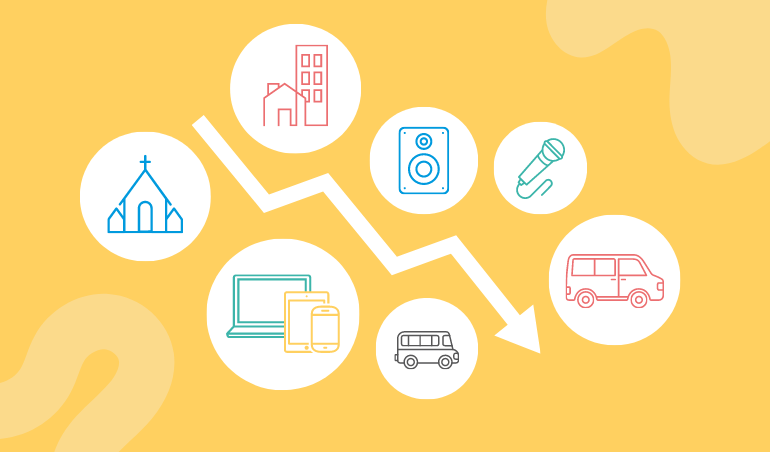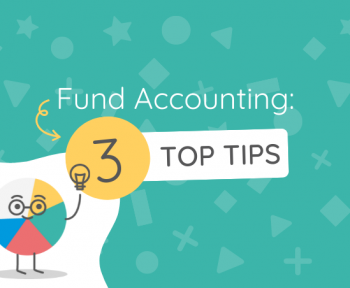This blog covers what fixed assets are, how they are accounted for within charity accounts and why this is important. It explains the concepts of capitalising fixed assets and depreciation of fixed assets.
What are fixed assets?
Fixed Assets are resources that fulfil all three of these criteria:
- You can measure the cost and the item is over a specified value (called the ‘capitalisation value’);
- Owned and used by your charity to carry out its day-to-day activities and operations;
- Not likely to be disposed of or sold within 12 months.
Examples may include:
- Computer and audio-visual equipment
- Musical instruments
- Fixtures and fittings
- Machinery and motor vehicles
- Freehold land and buildings
When you purchase a fixed asset, rather than appearing as expenditure, the value of the
fixed asset shows on the charity’s balance sheet. This process is called capitalisation.
Most fixed assets are expected to last and be used over a number of years. This varies by
asset type and is commonly referred to as the useful lifetime of the fixed asset.
Instead of appearing as expenditure upfront, the cost of fixed asset purchases is spread over
the useful lifetime of the asset. This process is called depreciation.
When a fixed asset is depreciated, this reduces its value shown on the charity’s balance sheet.
Note: charities with an income of less than £250k per year are typically able to create accounts on a Receipts and Payments basis (also known as cash accounting), rather than an accruals basis. Where this is the case, asset purchases are not capitalised as described above. Instead, you should record purchases as ‘expenditure’ and then state their current value on the Assets and Liabilities statement at year-end.
In the video below, Tim Wyatt, from Wyatt & Co Chartered Accountants, explains more about capitalisation and depreciation.
How does capitalisation of fixed assets work?
When a fixed asset is purchased, the purchase is recorded to a fixed asset category (rather than an expenditure category) and is recorded on the balance sheet.
From a balance sheet perspective, when a fixed asset is purchased:
- The cash line on the balance sheet decreases (as money is spent); and
- The fixed assets line on the balance sheet increases.
Thus, the total net assets of the charity do not change.
For example, if a charity spends £40,000 to purchase a minibus:
| Balance Sheet | Purchase of a Fixed Asset |
|---|---|
| Cash | DECREASES by £40,000 |
| Fixed Assets | INCREASES by £40,000 |
| Total Assets | No Change |
Why is capitalisation of fixed assets important?
Capitalising fixed assets helps provide a truer and more accurate picture of a charity’s finances. Fixed assets form part of a charity’s overall asset value.
If fixed asset purchases aren’t capitalised, but treated as expenditure, then every time you purchase a fixed asset, expenditure would spike and the total asset value of the charity would drop.
For example, imagine a charity with £60,000 of cash purchases a minibus costing £40,000.
If they capitalised the minibus purchase, the balance sheet would correctly show as £20,000 in cash plus the £40,000 value of the minibus.
If the purchase of the minibus wasn’t capitalised, then expenditure would increase by £40,000 and the net value of the charity would decrease by £40,000 (as they paid the £40,000 from the bank account). As a result, the charity’s asset value would wrongly show as £20,000.
| Balance Sheet | Prior to Minibus Purchase | Minibus Purchase Capitalised | Minibus wrongly treated as expenditure |
|---|---|---|---|
| Cash | £60,000 | £20,000 | £20,000 |
| Fixed Assets | £0 | £40,000 | £0 |
| Total Assets | £60,000 | £60,000 | £20,000 |
Which purchases should be capitalised?
The criteria for when to capitalise fixed asset purchases can differ between charities. Typically you do not capitalise low-value purchases. The value at which fixed asset purchases are capitalised is known as the capitalisation threshold.
For example, many smaller and medium-sized charities will have a capitalisation threshold that is between £500 to £1,000.
However, this is not a rule. For charities with higher income, the capitalisation threshold may be higher. Your charity accounting policy, which you can find within your year-end accounts, sets out the details of when to capitalise an asset purchase.
Where the value of a fixed asset purchase is below the capitalisation threshold, the purchase is treated as expenditure (i.e. the purchase is not capitalised).
This is sometimes referred to ‘being written off in the SOFA’ because the purchase cost is included in the expenditure figure in your Statement of Financial Activities (SOFA).
Over how many years should fixed assets be depreciated?
Most fixed assets are expected to last and be used over several years. This is commonly referred to as the useful lifetime of the fixed asset. It determines across how many years you spread the cost of a fixed asset.
The useful lifetime varies by asset type. For example, electrical items such as laptops may have a useful lifetime of 3 or 4 years. For items with a longer expected lifetime, such as tables and chairs, this may be 5 or 10 years.
The useful lifetime of a fixed asset is also referred to as the depreciation period.
Again, your charity accounting policy sets out the details of the depreciation periods for different fixed asset types.
Whilst you may hope that fixed asset purchases last for longer than the depreciation period (e.g. a laptop could last 7 to 8 years), it’s important not to overstate the depreciation period, as doing so could lead to your charity overstating its net assets on the balance sheet.
How does depreciation work?
Instead of appearing as expenditure upfront, the cost of fixed asset purchases is spread over the useful lifetime of the asset. This process is called depreciation.
For example, you purchase a catering oven for £3,000. If the catering oven has a depreciation period of 3 years, then £1000 of expenditure will show in each financial year.
| Year 1 | Year 2 | Year 3 |
|---|---|---|
| £1,000 | £1,000 | £1,000 |
When a fixed asset is depreciated, the fixed asset line on the balance sheet decreases. This also decreases the organisation’s total asset value.
Depreciation is classed as expenditure. It is included in both the Income and Expenditure reports on ExpensePlus, as well as the Statement of Financial Activities (SOFA) in your year-end accounts.
Each year when the catering oven fixed asset is depreciated, on the balance sheet:
- The fixed asset value decreases by £1,000
- Expenditure increases by £1,000
In this example, this will happen three times because the depreciation period of the asset is 3 years. After this period, the fixed asset value is zero.
| When the catering oven is purchased | At the end of Year 1 | At the end of Year 2 | At the end of Year 3 | |
|---|---|---|---|---|
| Fixed Asset Value | + £3,000 | -£1,000 (asset value £2,000) | -£1,000 (asset value £1,000) | -£1,000 (asset value £0) |
| Expenditure | £0 | +£1,000 | +£1,000 | +£1,000 |
Is depreciation always linear?
Typically, yes. Remember, depreciation is about spreading the purchase cost of the fixed asset over the useful lifetime of the asset.
Depreciation is not about trying to make the value of the fixed asset on your balance sheet reflect the current value of your fixed asset. For example, let’s take the minibus example from earlier in this article. Even though a minibus may lose 50% of its value in the first year it would typically be depreciated in a linear fashion across the lifetime of the asset (e.g. £4,000 per year over 10 years).
The exception to this is with land and building assets. Typically, these do not depreciate and instead should be revalued at least every 5 years. This article does not cover revaluation.
Fixed Assets are typically depreciated at the end of each financial year and depreciation isn’t applied pro-rata. For example, you purchase a laptop worth £1,500 and depreciate it over 3 years. At the end of year 1, it would depreciate by £500 regardless of whether it was purchased in month 1 of that year or month 10.
Can I use my fixed asset register to track assets?
Typically, you will need a spreadsheet to track assets, which is separate from your fixed asset register for accounting. This is because when tracking assets you may wish to:
- Track assets below the capitalisation threshold (and therefore do not appear in your fixed asset register).
- Track fully depreciated assets that no longer appear in your fixed asset register.
- Store non-financial information such as a photograph, the location of the asset, asset ID, when you last checked it, insurance arrangements, etc.
You may want to track the current asset value or replacement value for insurance purposes. These differ from the depreciated fixed asset value within your accounting fixed asset register.
Do fixed assets need to be stated in year-end accounts?
As well as the fixed assets value on your Balance Sheet, your year-end accounts will include a summary note of any fixed asset additions, disposals, revaluations, and depreciation during the year.
If you’re unsure about this, you should speak to your Independent Examiner or Auditor. As we’ve mentioned above, your year-end accounts should also include various accounting policies, including one that covers the capitalisation and depreciation of fixed assets.
How can ExpensePlus help?
ExpensePlus is an easy-to-use cloud-based fund accounting package designed for churches and charities that makes managing fixed assets simple.
When you enter a purchase, by simply recording it against a fixed asset category (rather than an expenditure category) the asset will automatically be capitalised, and will automatically appear both on your fixed asset register and on your balance sheet.
ExpensePlus has an inbuilt fixed asset register, where you can set a depreciation period for each of your fixed assets.
At year-end, you can depreciate fixed assets at the click of a button, and ExpensePlus automatically calculates the depreciation amount for you.
To find out more, check out this video Fixed Assets Module overview.
ExpensePlus is a cloud-based fund accounting software package designed for churches and charities. ExpensePlus makes managing fund accounts simple and straightforward. It’s used by hundreds of charities and churches across the UK and is rated 4.8 stars (out of 5) on Google with over 900 user reviews.







